Campus Trees are an Extension of Mount Holyoke’s Classrooms and History
To nearly everyone who has spent time on campus the memory of Mount Holyoke is a memory of trees: the whispering shade over conversations on Skinner Green, the blooms that brighten spring exams, the crimson and gold fanfare of Mountain Day.
The Mount Holyoke College campus features 1,200 planted trees and thousands more forest trees in the wilder areas on Prospect Hill and around Lower Lake and Upper Lake. The planted trees—representing more than 175 species—hail from dozens of countries. All are cared for by a team of college staff. All hold a history of this place.
Diverse Roots
Over the decades, the College’s trees have been planted thoughtfully, with an eye toward longevity, aesthetics across multiple seasons, and, increasingly, toward diversity.
“The diversity of students on campus is incredible—not just where they’re from, but their histories and what brought them here,” says Tom Clark, director and curator of the Mount Holyoke Botanic Garden. “Why shouldn’t the trees reflect that?”
Nearly half of campus trees are oaks, maples, and pines, but even within these steadfast local varieties, which include the large grove of sugar maples around Mary Lyon’s grave, there is remarkable variation. Look closely at the tall pine between the Kendall Hall parking lot and the playing fields—the campus’s sole lacebark pine—and you’ll see beneath its feathery needles a trunk that looks like marble: smooth and dappled with gold, grey, white, ruby, and green. The sugar maples behind Ciruti Center are of a variety (Newton Sentry) that grows tall and thin, like towering green pencils, without pruning or encouragement. The trunks of the maples near Brigham and Dickinson halls, and in the courtyard of the Willits-Hallowell Center, flaunt a deeply cinnamon-hued bark, which rolls off in rich, metallic-looking sheets to reveal a rose-colored trunk. These are paper-bark maples, a unique species native to central China, rare in the landscape because they are exceedingly difficult to grow from seed.
All across campus are pockets of trees difficult to find in local yards and greenways. A trident maple on Skinner Green, planted in 1996, grew from a seed sent to campus from Arborétum Mlyňany in Slovakia as part of an international seed exchange. Today Botanic Garden staff are raising many tree saplings grown from seeds collected by Clark and his colleagues on excursions to the trees’ distant home ranges. One such tree (a mountain pepperbush, its seed collected from North Carolina in 2014) will be mature enough to be planted on Botanic Garden grounds for Arbor Day this spring.
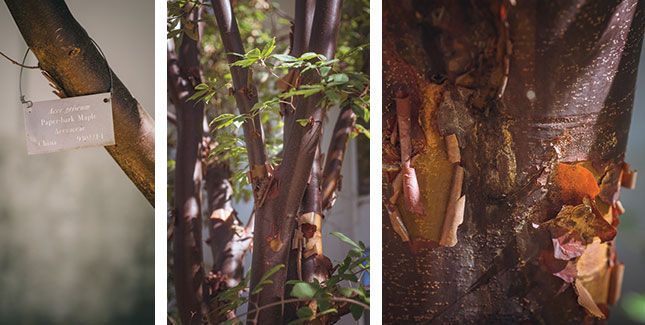
A paper-bark maple (Acer griseum) on the east side of Brigham Hall is one of five on campus;
a paper-bark near Miles-Smith is dedicated to Elizabeth Topham Kennan ’60.
On the north end of the Kendall Hall parking lot, on the way to the playing fields, is a rich concentration of unusual conifers, including bald cypress, golden larch, and an umbrella pine, one of the oldest tree species on earth (pre-dating the dinosaurs) and historically regarded as one of five sacred trees in its native Japan. This umbrella pine, planted in 2011, is the only one of its kind on campus, and for good reason; they’re very slow growers (this one is less than twenty feet tall), intolerant of drought and extreme cold, and unlikely to reach maturity in any of our lifetimes.
The tree’s glossy, needle-like leaves are soft to the touch and on close inspection reveal a surprise: they are actually not leaves at all (the real leaves are tiny brown scales) but modified stems made of the same unique material as cactus pads. The whorled, spreading arrangement on each branch, resembling the ribs of an umbrella, is how the tree got its name.
Lessons to be Learned
Each year, dozens of students use the trees on campus as a learning tool.
The Botanic Garden, which in its three acres includes many campus gardens and trees as well as the Talcott Greenhouse, is actually a department within the science division. Clark likens it to the Mount Holyoke Art Museum: “We exist to ourselves as a multi-faceted scientific entity but play a direct role in supporting the academic mission.”
Last summer three students interned with the Botanic Garden as part of the Mount Holyoke Lynk initiative, a program that will continue. Interns were involved with a wide range of activities, centered mostly on the care of the living collection within the Botanic Garden’s grounds, gardens, and greenhouses. They created interpretive materials and helped organize the First-Year Plant Sale, all while developing a broader understanding and appreciation of the diversity of plants and the vital role they play in the world.
Tree education is part of coursework, too. Students majoring in fields as diverse as biology, environmental studies, economics, and art come together in Biology Professor Martha Hoopes’ fall-term ecology class to monitor long-term study plots in the woods above Upper Lake. By identifying trees and shrubs and measuring their growth, students can observe the impacts of invasive species on local forest dynamics and explore pressing global change issues playing out right on campus.
Campus trees also have been the foundation for Local Flora, a class taught by Professor Amy Frary ’90, chair of biochemistry. Students in this class learn to identify more than seventy-five tree species and an equal number of smaller plant species, all from specimens on campus. “Knowing what’s out there really enhances your appreciation when you step outside,” says Frary. “It’s not just this massive anonymous green. You know that’s an oak, that’s a maple. It’s the same pleasure I get from taking art history classes and then going into a museum.”
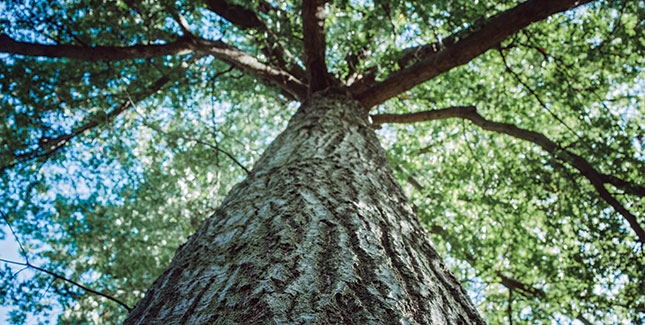
One of many on campus, this pin oak (Quercus palustris) stands on the west side of the Health Center.
Frary uses weekly walks and field trips to help students connect with the trees on a personal level. “I tell students, you’re going to know a bunch of new friends on campus by name—even in the winter, when it’s almost like a magic trick because there are no leaves.” Students’ final projects for the class tend to be interdisciplinary; recent presentations have focused on medicinal plants, tree diversity around a restored section of Lower Lake, and plant components used in fiber arts. In recent years, there have been long waiting lists for the class, which is capped at eleven students. “I sprinkle in a lot of natural history and bits of info that I don’t hold them responsible for,” Frary adds. “We do scratch-and-sniff twigs. They’re shocked that the distinctive odor of the black cherry tree is cyanide. And then we talk about why plants would be making these compounds.”
Sarah Paquet ’03 says she has retained more information from Frary’s class fifteen years ago than in “any other classroom, ever.” Whenever she returns to campus, a large sycamore between Mary Woolley Hall and the Rockies is always her first stop. Eastern sycamores are majestic native trees—one of the largest broad-leaved trees in the eastern United States—with a dense canopy that can grow well over one hundred feet high. Their broad trunks are flanked with marbled bark that tapers to a luminous ivory where sunlight filters into the upper branches. In fall, their broad, maple-like leaves turn golden yellow. The soft seed balls that give the tree its nickname (“button-wood”) provide food for finches and squirrels throughout the winter.

The College’s only umbrella pine (Sciadopitys verticillata), on the north end of the Kendall parking lot.
Tree Traditions
Many alumnae have touchstone trees that they return to during a campus visit. At least forty trees on campus are designated as “class trees,” planted or adopted by graduating or reunion classes. At the turn of the twentieth century, “tree exercises” and the adoption of a class tree were a standard part of Commencement weekend, held just after the alumnae meeting. In 1916 a notable tree exercise included a group of student leaders gathering at their tree to act out their four years in pantomime and song and then burying a box of class souvenirs near the tree’s roots, to be dug up at their twenty-fifth reunion.
Although official tree exercises are a thing of the past, more than half of the classes since 1940 have planted a tree. The species (selected in collaboration with Facilities Management and the Botanic Garden) range from small flowering dogwoods and magnolias to towering heritage oaks. Some are planted in memory of a classmate; others are planted in scenic locations or for a bloom color that corresponds to the class color. A magnificent river birch adopted by the class of 1987 sits between the Prospect Hall dining patio and Lower Lake. Unlike the river birches in domestic front yards, which are multi-trunked and heavily pruned, this tree has been allowed to mature into its natural form—with a wide, weeping canopy that shades a favorite student study spot (and provides habitat for Jorge the goose). The tree is visible from the newly renovated Blanchard Hall and Community Center, its golden leaves a standout in the diverse tableau lining the lake in fall.
A Long History
The ages of most campus trees are unknown. It wasn’t until 1990 that campus trees were systematically inventoried and labeled—work begun under former Director of the Botanic Garden Ellen Shukis. Since then, each tree has been tracked as part of a campus-wide plant database that’s rich with information about the plants’ origins. Look closely at the tags on campus trees; in addition to the plant’s name and home range, a numeric ID begins with the year the tree was planted. Trees planted before the 1990 census begin with an “E,” for “existing.”

The copper beech (Fagus sylvatica, Atropurpurea Group) near Dwight Hall is perhaps the most recognized tree on campus.
One older tree with a well-documented history is the copper beech outside Dwight Hall. Perhaps the best-known tree on campus, this beech of European origin was planted in 1904 by botany professor Asa Kinney to honor the birth of his daughter Elizabeth Kinney Worley, class of 1924. The beech, now more than eighty feet tall, with massive, elephantine branches and burgundy leaves that sweep the round windows of the library’s Octagon Room, is sometimes referred to as the “million dollar tree.” When the connector between the Miles-Smith library wing and Dwight Hall was built in 1990, the College went to costly lengths to ensure that the tree could remain, and that its sensitive surface roots would not be compromised by construction. Other construction efforts have been similarly mindful of the tree. In 2004 students, faculty, and alumnae gathered to celebrate the beech’s centennial with a cake.
When it comes to size, other showstopper trees on campus are the massive pin oaks, like the one that shades the Health Center, with soaring canopies and trunks four- feet wide. An educated guess would place their collective origin as the dozens of pin oaks planted throughout campus in the aftermath of the Great Hurricane of 1938, which blew down more than 1,200 trees on campus, including ninety percent of the trees on Prospect Hill. Major Otto C. Kohler, then superintendent of Buildings and Grounds, led a major replanting effort in 1946 to establish seventy pin oak and linden trees, mostly along College Street and in front of the library. (You will still find the originals in both places—similarly sized to the oak at the Health Center.) In 1948, an additional two hundred pin oaks, sycamores, crabapples, and scarlet oaks were planted, many of which still stand today near Skinner and Mary Woolley halls.
Subsequent storms have shown the resilience of campus trees, like the Halloween snowstorm of 2011, which damaged 90 percent of the planted trees on campus. All but fifty trees were saved and restored. A new tree was planted for every tree removed.
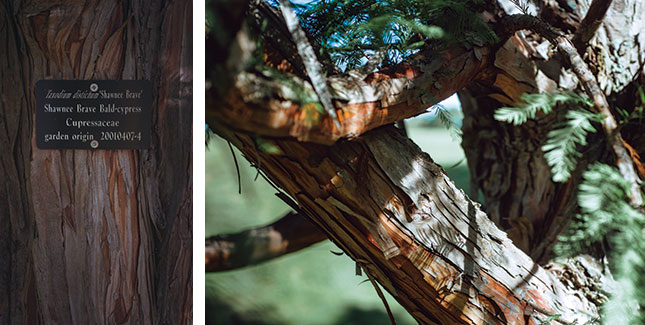
This Shawnee Brave Bald-cypress (Taxodium distichum) is one of three on campus, all on the north side of the Kendall Hall parking lot.
Today, wood from felled campus trees is recycled into building projects—lumber for doors, bureaus, cabinets, and even educational displays. Rings from a segment of an elm tree removed in 1997 are used in teaching geology students the growth variability that follows climate shifts, as part of Professor Alan Werner’s Global Climate Change class.
“We don’t throw a lot away,” says James Roy, carpentry supervisor for Facilities Management. “We try to reuse everything, down to the little pieces.” A red oak removed between the Rockies and Mary Woolley Hall was crafted by carpenter Mike Laizer into Shaker-style bookcases for Ciruti Center. An ash tree near Clapp became a door in Mary Lyon Hall and radiator covers for the President’s House. In his ten years at Mount Holyoke, Roy says he has purchased very little pine and hardwood for his shop’s carpentry projects. Not only are felled trees used for projects, but worn wood is repurposed. Dorm desks, dining hall tables, old cedar lamp posts, and cypress window sashes original to the nineteenth century greenhouse are all being reimagined into new and useful campus infrastructure. And in this way the trees of Mount Holyoke live on.
—By Clarisse Hart ’03
Clarisse Hart ’03 directs outreach and education at Harvard Forest, a research department of Harvard University, and is involved in her town government consulting on tree-related issues. She earned a master’s degree in nonfiction writing from Emerson College and is pursuing a doctorate in forest resources at the University of Massachusetts.
—Photographs by Anja Schütz
This article appeared as “Trees that Teach and are Remembered” in the winter 2018 issue of the Alumnae Quarterly.
January 11, 2018


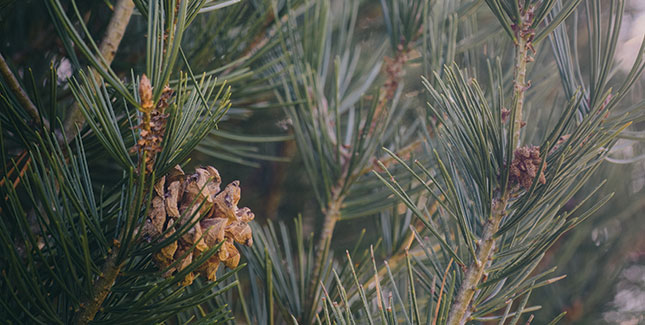







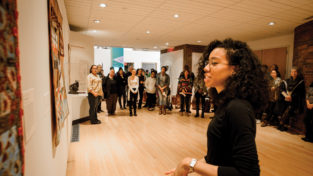

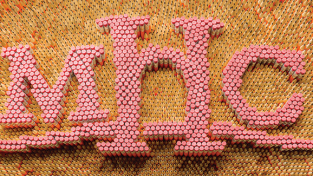
Such an amazing article, I always wondered why campus was SO PEACEFUL!
NEVER REALIZING ITS IN THE EARTH AND THE WAY THE GROUNDS ARE KEPT TO KEEP THE LOVE AND MEANING MOVING FORWARD!
ABSOLUTELY AMAZING, I CANT WAIT TO GO WALK THRU CAMPUS TOMORROW!
What a great article! Thank you. I will notice the trees of MHC a little closer the next time I am on campus. Reading this may even get me there sooner!
What a lovely and informative piece. Thanks, Clarisse! I didn’t know we had class trees on campus and am delighted that we do. I will try to find out if class of 2001 has adopted/planted any trees. Love the tree exercises history- new to me as well.
Hey Siobhan! I checked the database and it looks like the class of 2001 has two nice three-flowered maples (Acer triflorum) on the west side of Skinner. Cheers!
I was very pleased to see this article. I just attended reunion and, since I am a birder, I noticed mhc’s incredible trees! I wrote in my reunion comments that there be a tree tour. This article was like a tree tour. Thank you!
Among the joys of attending reunions is seeing Mount Holyoke’s splendid trees